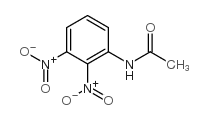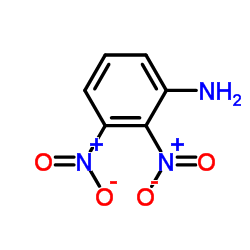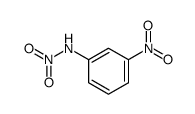610-41-3
| Name | 3,4-dinitroaniline |
|---|---|
| Synonyms |
3,4-dinitrophenylamine
3,4-dinitro-aniline 3,4-Dinitroanilin 3,4-dinitrobenzenamine MFCD00456811 Benzenamine,3,4-dinitro |
| Density | 1.376 g/mL at 25 °C(lit.) |
|---|---|
| Boiling Point | 71 °C(lit.) |
| Melting Point | 154-158 °C(lit.) |
| Molecular Formula | C6H5N3O4 |
| Molecular Weight | 183.12200 |
| Flash Point | >230 °F |
| Exact Mass | 183.02800 |
| PSA | 117.66000 |
| LogP | 2.71280 |
| Index of Refraction | 1.679 |
Synonym: Section 2 - COMPOSITION, INFORMATION ON INGREDIENTS
Risk Phrases: 23/24/25 33 Section 3 - HAZARDS IDENTIFICATION EMERGENCY OVERVIEW
Toxic by inhalation, in contact with skin and if swallowed. Danger of cumulative effects. Potential Health Effects Eye: May cause eye irritation. Skin: May cause skin irritation. Toxic in contact with skin. Ingestion: May cause irritation of the digestive tract. Toxic if swallowed. Inhalation: May cause respiratory tract irritation. Toxic if inhaled. Chronic: There is a danger of cumulative effects. Section 4 - FIRST AID MEASURES Eyes: Immediately flush eyes with plenty of water for at least 15 minutes, occasionally lifting the upper and lower eyelids. Get medical aid immediately. Skin: Get medical aid immediately. Immediately flush skin with plenty of water for at least 15 minutes while removing contaminated clothing and shoes. Ingestion: Get medical aid immediately. Wash mouth out with water. Inhalation: Get medical aid immediately. Remove from exposure and move to fresh air immediately. If not breathing, give artificial respiration. If breathing is difficult, give oxygen. Notes to Physician: Section 5 - FIRE FIGHTING MEASURES General Information: As in any fire, wear a self-contained breathing apparatus in pressure-demand, MSHA/NIOSH (approved or equivalent), and full protective gear. Extinguishing Media: Use water spray, dry chemical, carbon dioxide, or chemical foam. Section 6 - ACCIDENTAL RELEASE MEASURES General Information: Use proper personal protective equipment as indicated in Section 8. Spills/Leaks: Vacuum or sweep up material and place into a suitable disposal container. Section 7 - HANDLING and STORAGE Handling: Do not breathe dust, vapor, mist, or gas. Do not get in eyes, on skin, or on clothing. Use only in a chemical fume hood. Storage: Store in a cool, dry place. Store in a tightly closed container. Section 8 - EXPOSURE CONTROLS, PERSONAL PROTECTION Engineering Controls: Use adequate ventilation to keep airborne concentrations low. Exposure Limits CAS# 610-41-3: Personal Protective Equipment Eyes: Not available. Skin: Wear appropriate protective gloves to prevent skin exposure. Clothing: Wear appropriate protective clothing to prevent skin exposure. Respirators: Follow the OSHA respirator regulations found in 29 CFR 1910.134 or European Standard EN 149. Use a NIOSH/MSHA or European Standard EN 149 approved respirator if exposure limits are exceeded or if irritation or other symptoms are experienced. Section 9 - PHYSICAL AND CHEMICAL PROPERTIES Physical State: Powder Color: yellow Odor: Not available. pH: Not available. Vapor Pressure: Not available. Viscosity: Not available. Boiling Point: Not available. Freezing/Melting Point: 154 - 156 deg C Autoignition Temperature: Not available. Flash Point: Not available. Explosion Limits, lower: Not available. Explosion Limits, upper: Not available. Decomposition Temperature: Solubility in water: Specific Gravity/Density: Molecular Formula: C6H5N3O4 Molecular Weight: 183.12 Section 10 - STABILITY AND REACTIVITY Chemical Stability: Stable. Conditions to Avoid: Incompatible materials. Incompatibilities with Other Materials: Strong oxidizing agents, strong acids, acetic anhydride, acid chlorides, chlorine, hydrochloric acid. Hazardous Decomposition Products: Nitrogen oxides, carbon monoxide, carbon dioxide. Hazardous Polymerization: Will not occur. Section 11 - TOXICOLOGICAL INFORMATION RTECS#: CAS# 610-41-3 unlisted. LD50/LC50: Not available. Carcinogenicity: 3,4-Dinitroaniline - Not listed by ACGIH, IARC, or NTP. Section 12 - ECOLOGICAL INFORMATION Section 13 - DISPOSAL CONSIDERATIONS Dispose of in a manner consistent with federal, state, and local regulations. Section 14 - TRANSPORT INFORMATION IATA Shipping Name: DINITROANILINES Hazard Class: 6.1 UN Number: 1596 Packing Group: II IMO Shipping Name: DINITROANILINES Hazard Class: 6.1 UN Number: 1596 Packing Group: II RID/ADR Shipping Name: DINITROANILINES Hazard Class: 6.1 UN Number: 1596 Packing group: II Section 15 - REGULATORY INFORMATION European/International Regulations European Labeling in Accordance with EC Directives Hazard Symbols: T Risk Phrases: R 23/24/25 Toxic by inhalation, in contact with skin and if swallowed. R 33 Danger of cumulative effects. Safety Phrases: S 28A After contact with skin, wash immediately with plenty of water. S 36/37 Wear suitable protective clothing and gloves. S 45 In case of accident or if you feel unwell, seek medical advice immediately (show the label where possible). WGK (Water Danger/Protection) CAS# 610-41-3: No information available. Canada None of the chemicals in this product are listed on the DSL/NDSL list. CAS# 610-41-3 is not listed on Canada's Ingredient Disclosure List. US FEDERAL TSCA CAS# 610-41-3 is not listed on the TSCA inventory. It is for research and development use only. SECTION 16 - ADDITIONAL INFORMATION N/A |
| Hazard Codes | T,Xi |
|---|---|
| Risk Phrases | R23/24/25 |
| Safety Phrases | S28-S37-S45 |
| RIDADR | UN 1596 6.1/PG 2 |
| WGK Germany | 2 |
| Packaging Group | II |
| Hazard Class | 6.1 |
| HS Code | 2921420090 |
|
~93% 
610-41-3 |
| Literature: Nielsen, Arnold T.; Atkins, Ronald L.; Norris, William P.; Coon, Clifford L.; Sitzmann, Michael E. Journal of Organic Chemistry, 1980 , vol. 45, # 12 p. 2341 - 2347 |
|
~% 
610-41-3 |
| Literature: Journal of Organic Chemistry, , vol. 45, # 12 p. 2341 - 2347 |
|
~% 
610-41-3 |
| Literature: Journal of the Chemical Society, , p. 1897 |
|
~% 
610-41-3 |
| Literature: Journal of the Chemical Society, Perkin Transactions 2: Physical Organic Chemistry (1972-1999), , p. 1767 - 1772 |
|
~% 
610-41-3 |
| Literature: Gazzetta Chimica Italiana, , vol. 19, p. 233 Jahresbericht ueber die Fortschritte der Chemie und Verwandter Theile Anderer Wissenschaften, , p. I,775 |
|
~% 
610-41-3 |
| Literature: Justus Liebigs Annalen der Chemie, , vol. 311, p. 111 |
|
~%
Detail
|
| Literature: Chemistry and Industry (London, United Kingdom), , p. 1290 |
| HS Code | 2921420090 |
|---|---|
| Summary | HS:2921420090 aniline derivatives and their salts VAT:17.0% Tax rebate rate:9.0% Supervision conditions:none MFN tariff:6.5% General tariff:30.0% |







